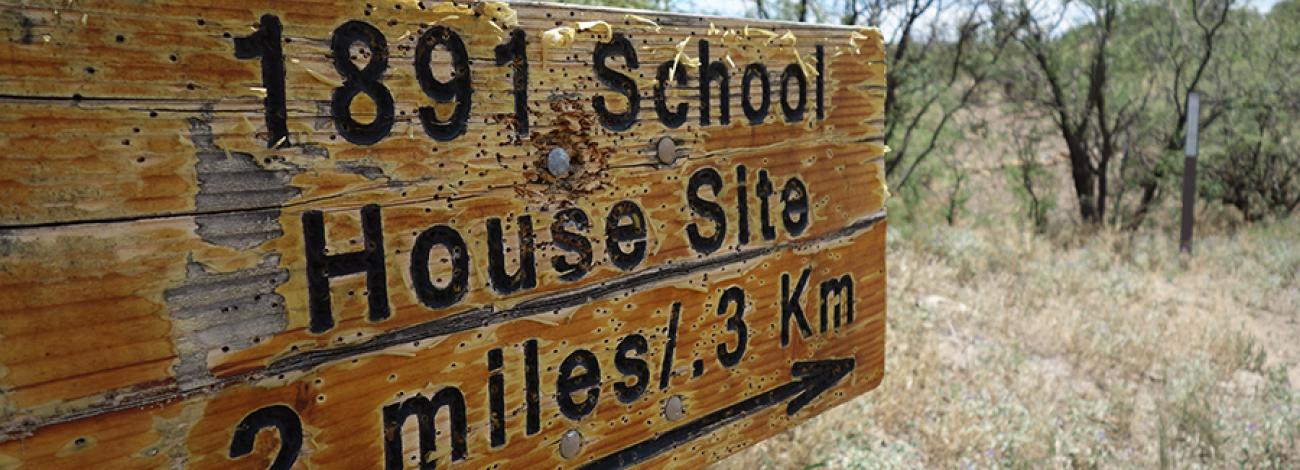
1891 Schoolhouse | Arizona
A short trail leads from the parking area to the site of the 1891 Schoolhouse, which operated along the Agua Fria River until 1903.
On Sept. 12, 1891, U.S. Deputy Surveyor Francis B. Jacobs recorded a schoolhouse at this location along the Agua Fria River. Over 118 years later, Jacobs' map and field notes were rediscovered, spawning a search for information about the school and its location. Based on the 1891 survey map, the school was named the “1891 Schoolhouse.” Using field notes and the map as a guide, the location of the schoolhouse was identified. Although the building is gone, the sense of place is still intact. The remoteness and its history exemplify the need, importance, and desire of the settlers of Territorial Arizona for their children to get an education. Students would walk and ride horses and wagons to this distant location to meet in a single-room schoolhouse. Here they learned, played, and socialized in order to better themselves, their community and country.
What once stood here?
Although no photographs of the school are known to exist, a Yavapai County Superintendent’s Report for 1889-1890 states, “the school has sufficient school grounds that are suitably improved, was well ventilated, but poorly supplied with furniture and apparatus, and had no library, but a water closet.”
Based on archaeological artifacts, the partial remains of the rock foundation, historical documentation, and known construction techniques used at other contemporaneous schools in the area, the following can be surmised about the schoolhouse: it measured approximately 16 feet by 28 feet, was a wooden frame structure with a wooden floor resting directly on a rock foundation, and most likely had vertical board siding. In addition, the school had multiple windows and, what as was custom of the time, a single entrance door.
Students
The students that attended the school were mostly from the local rural ranching and farming community within the school district, but students from outside the district were also enrolled. The ages of the students varied from 6 to 18 years old, and they were allowed to progress through their studies at their own pace, with younger students learning from the older ones. Enrollment varied from a low of 12 to a high of 24 students during the years of 1889 to 1903, with a fairly equal number of boys and girls. A number of the students went on to become teachers themselves, with some returning to the school to teach.
School life
The first documented year of operation started on Sept. 9, 1889. The typical school year ran from five to eight months, starting on the second Monday in September. The school day lasted no more than six hours and only four hours for pupils under 8 years old. School started at 9 am and ended at 4 pm with a 20-minute recess in the morning and afternoon, during which students played games like ante-over, steal sticks, and baseball. The lunch hour started at noon, when the students would eat their lunches they brought from home in tin lard pails.
The Cordes District #41 schoolhouse, also known as the “1891 Schoolhouse” ceased operation at the end of the 1903 school year. Declining enrollment ultimately resulted in the school's closing. Built as a public school by local families for their children, it provided the hope of a better and enriched future for their children and community. In addition to the standard curriculum of the time, the principles of morality, truth, justice and patriotism, free government, the rights, duties, and dignity of American citizenship were also impressed upon the students. The knowledge and principles the students gained perhaps helped transform a territory into a state on Feb. 14, 1912.
Learn more at the Friends of the Agua Fria website.
Photos
Contact Us
Activities
Addresses
Geographic Coordinates
Directions
From Cordes Lakes, go east on Quail Run Road, which leaves town and turns to a well-maintained dirt road. From the beginning of the dirt road portion, continue 0.25 miles. Bear left at the fork in the road and continue toward the EZ Ranch. Drive 1.25 miles to the River Bend area and look for the BLM kiosk.
Fees
The 1891 Schoolhouse is free (no fee required) for general visits by the public.
However, commercial, competitive, and large organized group events require a special recreation permit. Contact the Hassayampa Field Office for more information about special recreation permits.





